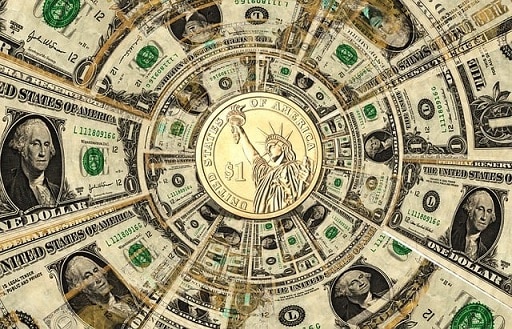For nearly 75 years, the US dollar has retained its place as the global reserve currency. Yet as the landscape of global finance evolves, the balances are beginning to tip. From new trade flows to digital currencies and the aftermath of sanctions, the dollar now faces challenges on all sides.
So is the era of “de-dollarisation” finally upon us, or are these fears overblown? Here are the factors that could threaten the dollar’s continued dominance and what it means for the future of FX.
The dollar has something powerful on its side: history.
After World War II, meetings at the Bretton Woods Conference were held to establish international norms of foreign exchange. These talks resulted in the Bretton Woods system, which pegged the dollar to gold and other currencies to the dollar.
This formal recognition granted the dollar significant power in both trade and as an intervention currency, though it also came with risks. In the 1960s, foreign exchange traders made repeated runs on the dollar, spurring inflation and unrest in America. Finally, in 1971, President Nixon decoupled the dollar from gold and put an end to fixed exchange rates.
Despite this decision, the USD held strong for much of the 20th century. Nixon’s Treasury Secretary John Connally summed up its authority like this: “The dollar is our currency, but it’s your problem.”
The dollar’s 21st-century hurdles
Today, the dollar still accounts for over 58% of global foreign exchange reserves, but its majority stake has slowly eroded over the past two decades. Since 2000, the dollar’s share of global reserves has dropped by 12 percentage points.
Does this represent a loss of confidence in the greenback, or is it simply a sign of the increasingly global nature of our economy? Here are the factors that stoke speculation about the dollar’s long-term position.
The ascendance of Brazil, Russia, India, China, and South Africa — known by the acronym BRICS — has shifted the global economic order. In 2023, BRICS produces a higher share of global GDP than the G7. And with greater BRICS influence comes the opportunity to conduct trade on new terms, sometimes without the dollar.
One striking example comes from an April agreement to settle trade between China and Brazil using the yuan. China is now Brazil’s largest trading partner, and this deal allows the two nations to transact $150 billion annually independent of the dollar — a move that has the potential to signal a shift in high-volume trading between countries with significant resource deposits.
The yuan was also used to complete an energy deal with France’s TotalEnergies involving 65,000 tons of Emirati liquified natural gas. Although it currently makes up just 3% of foreign reserves, more trade backed by China’s currency — including Saudi Arabia and the United Arab Emirates — may be on the horizon.
For years, Russia has sought to cut back its dependency on the dollar. Now, following a set of extraordinary financial sanctions in 2022, this process may further accelerate.
There are significant roadblocks to CBDC adoption, however. The chief concern is a lack of interoperability, meaning trade and the broader monetary ecosystem would be left further disconnected
Gita Gopinath, deputy managing director at the IMF, told the Financial Times that Western sanctions on Russia could “encourage the emergence of small currency blocs based on trade between separate groups of countries.” Even with the dollar as the majority global currency, she describes, “Fragmentation at a smaller level is certainly quite possible.”
Whether fragmentation will actually chip away at the dollar remains to be seen, but ongoing conflicts illustrate the fraught nature of reserve currencies in an age where nations have a wider range of options for FX and cross-border commerce.
A growing case for CBDCs
In addition to geopolitical turmoil and burgeoning trade alliances, some monetary decision-makers are seeking alternatives to the dollar due to inefficiencies with traditional currencies in times of crisis.
The dollar, as with other currencies, saw major fluctuations in the wake of the COVID-19 pandemic. More recently, a months-long battle with inflation coincided with the dollar index hitting one-year lows.
Events such as these bolster the case for innovations such as Central Bank Digital Currencies (CBDCs). More than 100 countries are currently researching or developing CBDCs, with the ultimate goal of tokenizing any currency to settle international transactions. If they are successful, it would be another tally against the dollar as the de facto reserve.
There are significant roadblocks to CBDC adoption, however. The chief concern is a lack of interoperability, meaning trade and the broader monetary ecosystem would be left further disconnected. Networks like SWIFT are racing to develop systems for central bank–backed digital transactions, but until then it’s unlikely that CBDCs will challenge the dollar’s primacy.
The dollar isn’t going to fade away overnight. More than 65 countries still peg their currencies to the USD, and the demand for dollars remains high.
As Gopinath of the IMF notes, regulation for new technologies like CBDCs and the internationalization of the yuan “are slow-moving process[es] that take time.” Meanwhile, the list of viable replacements for the dollar is slim.
For now, the USD’s reign continues — but at a time when international finance moves faster than ever, even the dollar isn’t completely future-proof.
Related
Guillaume Dejean on the threat of de-dollarisation
Fintech leaders discuss CBDC adoption

